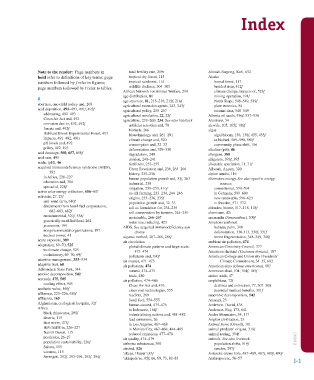Page 760 - Environment: The Science Behind the Stories
P. 760
Index
Note to the reader: Page numbers in total fertility rate, 219t Akosah-Sarpong, Kofi, 652
bold refer to definitions of key terms; page tropical dry forest, 115 Alaska
numbers followed by f refer to figures; tropical rainforest, 114 boreal forest, 117
page numbers followed by t refer to tables. wildlife declines, 304–305 braided river, 412f
African Network for Animal Welfare, 294 climate change, impacts of, 523f
age distribution, 81 mining operation, 191f
A age structure, 81, 215–216, 215f, 216f North Slope, 548–549, 549f
abortion, one-child policy and, 208 agricultural extension agents, 243, 243f plate tectonics, 54
acid deposition, 491–493, 491f, 493f agricultural policy, 255–257 seismic data, 548–549
addressing, 492–493 agricultural revolution, 22, 22f Alberta oil sands, 536f, 537–538
Clean Air Act and, 492 agriculture, 232–260, 234. See also livestock Aleutians, 54
corrosion due to, 492, 492f artificial selection and, 70 alewife, 105, 105f, 106f
forests and, 492f biofuels, 266 algae
Hubbard Brook Experimental Forest, 493 biotechnology and, 261–291 algal bloom, 130, 130f, 455, 455f
impacts, 491–492, 491t climate change and, 520 as biofuel, 589–590, 589f
pH levels and, 492 consumption and, 32–33 community phase shift, 106
policy, 492–493 deforestation and, 329–330 alkaline (pH), 46
acid drainage, 560, 657, 658f degradation, 240 allergens, 388
acid rain, 491 erosion, 240–241 alligators, 393f, 395
acidic (pH), 46 fertilizers, 253–255 allopatric speciation, 71, 71f
acquired immunodeficiency syndrome (AIDS), Green Revolution and, 236, 265–266 Allwash, Azzam, 320
382 history, 235–236 alpine tundra, 116
in Africa, 226–227 human population growth and, 33f, 263 alternative energy. See also specific energy
education and, 384 industrial, 236 sources
spread of, 228f irrigation, 250–253, 416f conventional, 570–594
active solar energy collection, 606–607 no-till farming, 233–234, 244–246 in Germany, 599–600
activism, 27, 27f origins, 235–236, 235f new renewable, 598–623
anti-wind farm, 610f population growth and, 32–33 in Sweden, 571–572
divestment from fossil fuel corporations, soil as foundation for, 234–236 altitudes, biome, 117–118, 118f
682–683, 682f soil conservation by farmers, 244–250 aluminum, 42t
environmental, 529f, 538f sustainable, 266–267 amaranths (Amaranthus), 309f
genetically modified food, 262 water use, reducing, 423 Amazon rainforest
grassroots, 199 AIDS. See acquired immunodeficiency syn- babassu palm, 310
nongovernmental organizations, 197 drome deforestation, 330-313, 330f, 331f
nuclear power, 41 aigamo method, 287–288, 288f forest fragmentation, 348–349, 348f
acute exposure, 389 air circulation ambient air pollution, 474
adaptation, 69–70, 525 global climate patterns and large-scale, American Chemistry Council, 377
to climate change, 525 473–474 American chestnut (Castanea dentata), 107
evolutionary, 69–70, 69f pollutants and, 390f American College and University Presidents’
adaptive management, 333–334 air masses, 471–473 Climate Commitment, 34–35, 682
adaptive trait, 68 air pollutants, 474 American elms (Ulmus americana), 107
Adirondack State Park, 344 natural, 474–475 American shad, 104, 104f, 105f
aerobic decomposition, 542 toxic, 480 amino acids, 47
aerosols, 475, 505 air pollution, 474–486 amphibians, 72f
cooling effect, 505 Clean Air Act and, 476 declines and extinction, 77, 307–308
aesthetic value, 169f clean coal technologies, 555 potential medical benefits, 311f
affluence, 225–226, 630f feedlots, 269 anaerobic decomposition, 542
affluenza, 165 fossil fuel, 554–555 Anasazi, 23
Afghanistan, ecological footprint, 32f human-caused, 475–476 Anderson, David, 438
Africa in Indonesia, 164f Anderson, Ray, 173, 641
black rhinoceros, 299f industrializing nations and, 481–482 Andes Mountains, 54, 117
deserts, 115 lead emissions, 26 Angkor civilization, 23
dust storm, 475f in Los Angeles, 467–468 Animal Farm (Orwell), 101
HIV/AIDS in, 226–227 in Mexico City, 467–468, 484–485 animal products’ origins, 319f
Namib Desert, 115 reduced emissions, 477–478 animal testing, 394f
pesticides, 26–27 air quality, 474–479 animals. See also livestock INDEX
population sustainability, 226f airborne substances, 390 population shifts, 519f
Sahara, 115 airshed, 126 species, 297f
savanna, 115 ‘akepa, Hawai‘i,83f Antarctic ozone hole, 487–489, 487f, 489f, 490f
Serengeti, 292f, 293–294, 293f, 294f ‘akiapola’au, 65f, 66, 69, 73, 82–83 Anthropocene, 56–57
I-1
Z09_WITH7428_05_SE_INDEX.indd 1 13/12/14 11:39 AM

